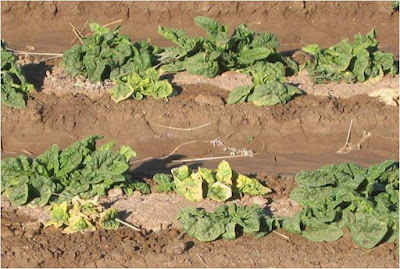 |
| Tomato infected with Beet Curly Top Virus Characteristic symptoms include curled, thickened (stiff) foliage with purple coloration on the underside of the leaves. (Photo: N. Goldberg, NMSU - PDC) |
Symptoms vary depending on the host; however, this disease also produces some general symptoms. Other factors that relate to the type and severity of symptom development include virus strain and host physiology. The virus exists in many different strains, which vary in the severity of symptoms produced particularly in relation to the host. Severity of disease is also dependent on the age of the plant when infected. For example, when young plants are infected they will often die shortly after infection. When plants are infected after the seedling stage, the plants survive but are yellow and stunted. Infected leaves of some hosts, particularly tomatoes and peppers, become thickened and crisp or stiff, and roll upward as the petioles curve downward. The leaves turn yellow with purplish veins. Leaves of other hosts such as beets become very twisted and curly. In most cases, yield is reduced, and the fruit that is produced ripens prematurely. The immature, dull and wrinkled fruit is a good diagnostic symptom for tomatoes infected with CTV. If plants are infected after they have begun to set fruit, it is not uncommon to see infected and healthy fruit on the same stem.
 |
| Beet Curly Top Virus on chile peppers (Photo: N. Goldberg, NMSU - PDC) |
 |
| Pumpkin infected with Beet Curly Top Virus (Photo: N. Goldberg, NMSU - PDC) |
 |
| Beet Curly Top Virus infected bean next to a healthy bean plant (Photo: J. French, NMSU - PDC) |
 |
| Beet Curly Top Virus on spinach (Photo: N. Goldberg, NMSU - PDC) |

No comments:
Post a Comment